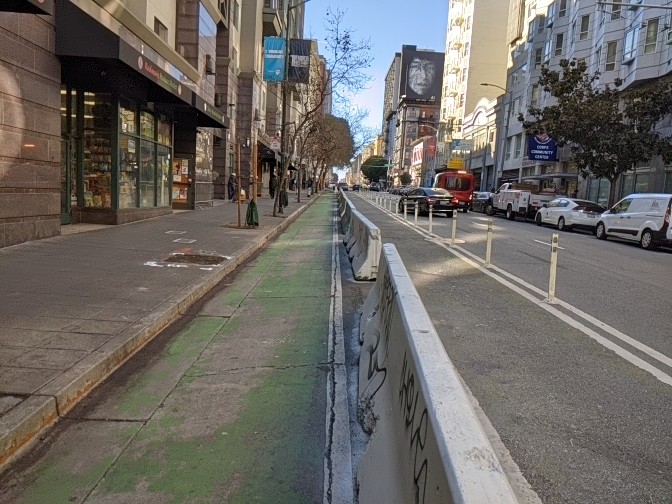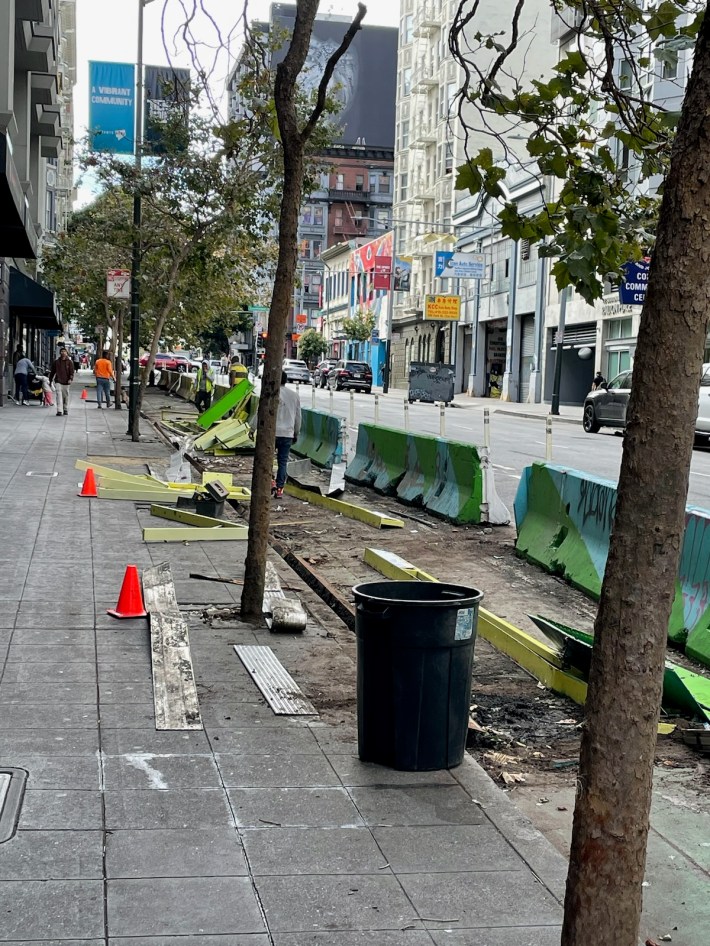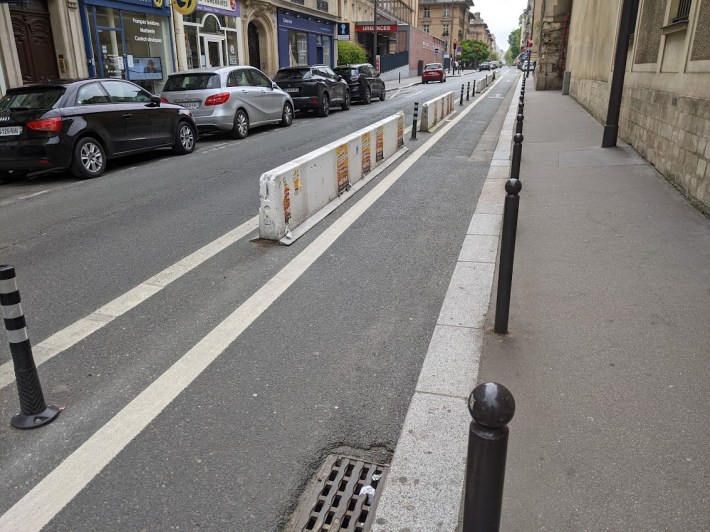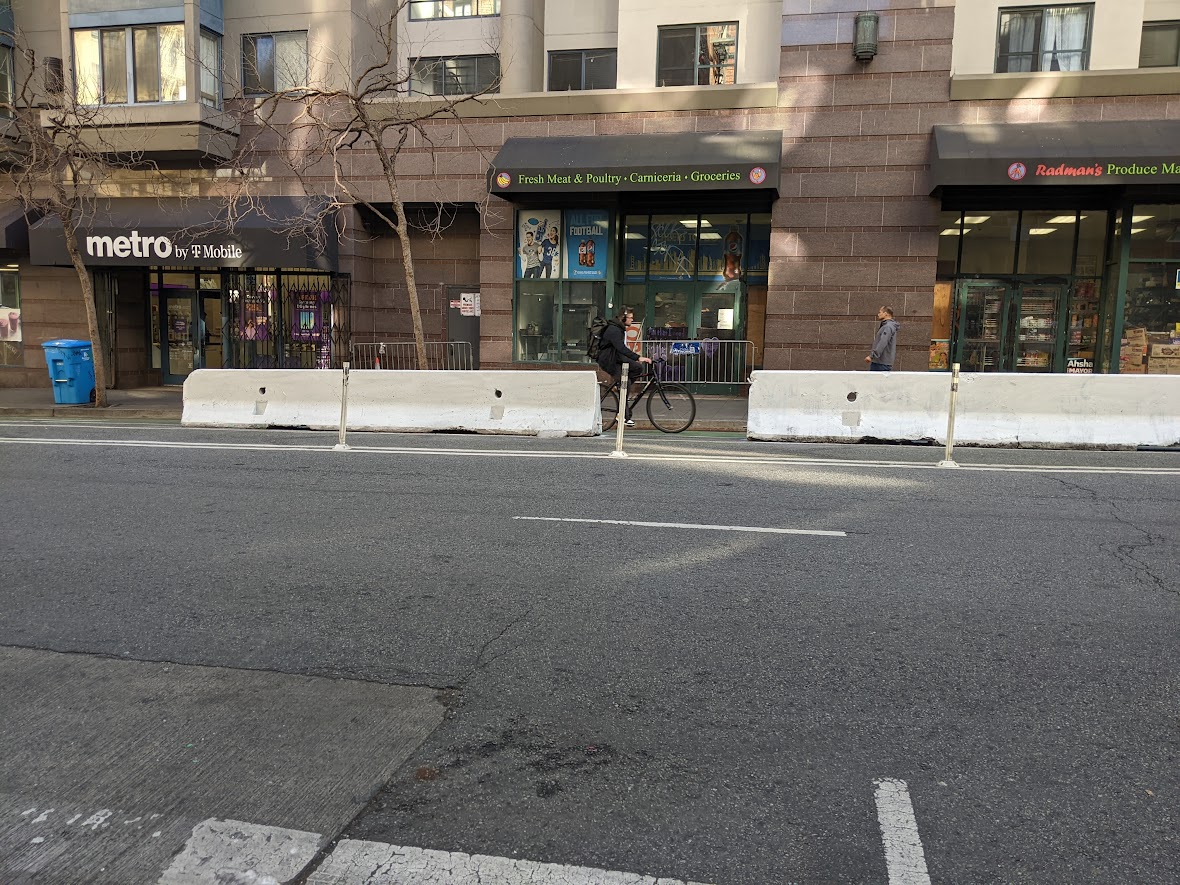Travel to New York, Paris, and other cities that have actually reduced the number of serious and fatal crashes on their streets, and one will find block after block of bike lane protected by Jersey barriers, as seen above. Except the lead image isn't from one of those cities.
It's from San Francisco.

On the 200 block of Turk Street in the Tenderloin, there's a block of quick-build protected bike lane that was unintentionally constructed like a New York-or Paris-style lane, lined by heavy concrete barriers. Back when the world was still reeling from the COVID-19 pandemic, the Jersey barriers were put in to expand the sidewalk and provide space for social distancing, explained a spokesperson for San Francisco Public Works. The space was then used for a parklet project led by the Tenderloin Community Benefits District (TCBD). The parklet was removed last fall. "Wood was hella rotten and nobody really used it," said one observer who works in the area.

Note the pre-parklet green paint of the original Turk bike lane, as seen in the most recent photo two images up. SFMTA also painted a second bike lane that bends around the location of the former parklet. And while the paint markings are hella confusing, with bike lanes now going on both sides of the Jersey barriers, the lead image shows how cyclists are figuring it out.
Obviously, the space between the curb and the Jersey barrier is no longer needed for COVID-era social distancing. What remains is, for all intents and purposes, a local example of how quick-build, protected bike lanes could and should work to truly keep cyclists (and pedestrians on the sidewalk) safe from errant motorists.
Michael Roccaforte, a spokesperson for SFMTA, points out that the city does use Jersey barriers (also know as K-rail) to protect cyclists in a handful of freeway-like locations, such as San Jose Avenue in the Bernal Cut and Hunters Point Boulevard. They also have long-term projects in the works that will use standard-size concrete curbs, such as on Folsom and Howard. However, he adds, "on most city streets, we need to allow paratransit access to the sidewalk, which prevents us from using K-rail more often."
So if that's the case, why was it possible to use the barriers to protect an area for social distancing and a parklet, but it's not possible to use it to protect cyclists on bike lanes? Obviously, there was and still are paratransit vehicles that have to access Turk Street in the Tenderloin.

Unofficially, Streetsblog has been told by SFMTA staffers that New York, Paris, and other cities don't value disability access as much as San Francisco. But again, this doesn't explain why Jersey barriers were used at this particular spot in the Tenderloin. It also belies the fact that there are lots of ways to accommodate wheelchair access—note there are gaps in the Jersey barriers for the parklet, which one also finds in similar installations in other cities when they're used for bike lane protection. Furthermore, in Streetsblog's view, the SFMTA excuse is insulting to the people of New York, Paris, and other places that are succeeding at making streets safer while SFMTA fails.
"We need truly protected and separated infrastructure for people to bike and roll—we also expect SFMTA can and should create curb access on our streets for seniors and people with disabilities," wrote the San Francisco Bicycle Coalition's Christopher White in an email to Streetsblog about the setup on Turk and its implications.

Walk S.F. and the Vision Zero Coalition’s Senior & Disability Working Group even produced a comprehensive design guide in 2019 called Getting to the Curb, based on international best practices. It is all about how to accommodate paratransit access with protected bike lanes. And one only has to head to Oakland or San Jose to see examples of ramps that accommodate both paratransit and protected bike lanes. And SFMTA itself, at least its transit department, has installed quick-build bus boarding islands on Fulton Street and at Market and Church Street. These islands accommodate paratransit without providing direct access to the curb, by including a ramp and curb cut.
"It's as though protecting people on bikes and scooters is not a priority," quipped Luke Bornheimer of Streets Forward.
From Streetsblog's view, that's the only conclusion one can draw. The new mayor needs to step in and make Jersey barrier protection the new norm for quick-build bike lane projects throughout the city. In fact, it's ridiculous to call a bike lane "protected" at all if it doesn't have a Jersey barrier or something else substantial enough to physically stop a car. Otherwise, what exactly is the lane protected against? Either way, the solution for disability access can't be to allow crashes that end up killing and disabling more cyclists and pedestrians.
"We're confident these two important needs can co-exist with some creativity from the agency and leadership from city officials," wrote White.
Streetsblog reached out to Mayor Lurie for this post. An incoming member of his staff responded but deferred to SFMTA for now. Streetsblog also reached out to incoming Supervisor Bilal Mahmood and disability advocates and may update this post.





